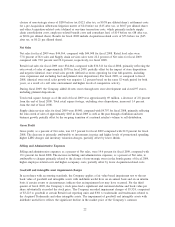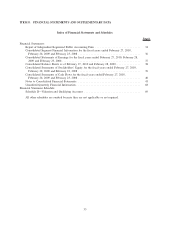Albertsons 2010 Annual Report Download - page 30
Download and view the complete annual report
Please find page 30 of the 2010 Albertsons annual report below. You can navigate through the pages in the report by either clicking on the pages listed below, or by using the keyword search tool below to find specific information within the annual report.Vendor Funds
The Company receives funds from many of the vendors whose products the Company buys for resale in its
stores. These vendor funds are provided to increase the sell-through of the related products. The Company
receives vendor funds for a variety of merchandising activities: placement of the vendors’ products in the
Company’s advertising; display of the vendors’ products in prominent locations in the Company’s stores;
supporting the introduction of new products into the Company’s retail stores and distribution system;
exclusivity rights in certain categories; and to compensate for temporary price reductions offered to customers
on products held for sale at retail stores. The Company also receives vendor funds for buying activities such as
volume commitment rebates, credits for purchasing products in advance of their need and cash discounts for
the early payment of merchandise purchases. The majority of the vendor fund contracts have terms of less
than a year, with a small proportion of the contracts longer than one year.
The Company recognizes vendor funds for merchandising activities as a reduction of Cost of sales when the
related products are sold. Vendor funds that have been earned as a result of completing the required
performance under the terms of the underlying agreements but for which the product has not yet been sold are
recognized as reductions of inventory. The amount and timing of recognition of vendor funds as well as the
amount of vendor funds remaining in ending inventory requires management judgment and estimates.
Management determines these amounts based on estimates of current year purchase volume using forecast and
historical data and review of average inventory turnover data. These judgments and estimates impact the
Company’s reported operating earnings and inventory amounts. The historical estimates of the Company have
been reliable in the past, and the Company believes the methodology will continue to be reliable in the future.
Based on previous experience, the Company does not expect there will be a significant change in the level of
vendor support. However, if such a change were to occur, cost of sales and advertising expense could change,
depending on the specific vendors involved. If vendor advertising allowances were substantially reduced or
eliminated, the Company would consider changing the volume, type and frequency of the advertising, which
could increase or decrease its advertising expense. Similarly, the Company is not able to assess the impact of
vendor advertising allowances on creating additional revenues as such allowances do not directly generate
revenue for the Company’s stores. For fiscal 2010, a 1 percent change in total vendor funds earned, including
advertising allowances, with no offsetting changes to the base price on the products purchased, would impact
gross profit by less than 10 basis points.
Inventories
Inventories are valued at the lower of cost or market. Substantially all of the Company’s inventory consists of
finished goods. Approximately 79 percent and 81 percent of the Company’s inventories were valued using the
last-in, first-out (“LIFO”) method for fiscal 2010 and 2009, respectively. The Company uses a combination of
the retail inventory method (“RIM”) and replacement cost method to determine the current cost of its
inventory before any LIFO reserve is applied. Under RIM, the current cost of inventories and the gross
margins are calculated by applying a cost-to-retail ratio to the current retail value of inventories. Under the
replacement cost method, the most current unit purchase cost is used to calculate the current cost of
inventories. The first-in, first-out method (“FIFO”) is used to determine cost for some of the remaining highly
perishable inventories. If the FIFO method had been used to determine cost of inventories for which the LIFO
method is used, the Company’s inventories would have been higher by approximately $264 and $258 as of
February 27, 2010 and February 28, 2009, respectively.
During fiscal 2010, 2009 and 2008, inventory quantities in certain LIFO layers were reduced. These reductions
resulted in a liquidation of LIFO inventory quantities carried at lower costs prevailing in prior years as
compared with the cost of fiscal 2010, 2009 and 2008 purchases. As a result, Cost of sales decreased by $22,
$10 and $5 in fiscal 2010, 2009 and 2008, respectively.
In addition, the Company evaluates inventory shortages throughout the year based on actual physical counts in
its facilities. Allowances for inventory shortages are recorded based on the results of these counts to provide
for estimated shortages as of the financial statement date. Although the Company has sufficient current and
24
























